7 Essential Examples of Psychological Safety at Work in 2025
Did you know that nearly 70% of employees in 2025 say psychological safety is their top workplace priority? As organizations adapt to remote collaboration, bold DEI initiatives, and constant change, fostering a safe environment has never been more crucial. This shift is transforming how teams share ideas, innovate, and thrive.
Why does it matter? Research shows that psychological safety drives higher innovation, boosts retention, and directly impacts team performance. Leading HR studies confirm that when people feel safe to speak up, companies see measurable gains across the board.
In this article, you’ll discover seven essential, actionable examples of psychological safety at work that are defining success in 2025. Ready to see what sets the best organizations apart?
Understanding Psychological Safety at Work
Psychological safety has become a cornerstone of thriving organizations in 2025. In its simplest form, psychological safety is the shared belief among team members that it is safe to take interpersonal risks, voice concerns, and contribute ideas without fear of embarrassment or retaliation. This environment is the foundation for high-performing teams, especially as workforces continue to evolve.
The concept was first introduced by Professor Amy Edmondson in the late 1990s. Her research showed that teams with high psychological safety were more likely to learn from mistakes and innovate. Later, Google’s Project Aristotle reinforced these findings, identifying psychological safety as the most critical factor in team effectiveness. As organizations adapt to remote work, global collaboration, and rapid technological change, these insights are more relevant than ever.
Today, the need for psychological safety is heightened. Hybrid teams, cross-cultural communication, and increased workplace stress demand environments where employees feel secure. Without psychological safety, teams are less likely to share knowledge, experiment, or challenge the status quo. Leaders now recognize that fostering this climate is essential for resilience and adaptability.
The business case for psychological safety is compelling. According to recent studies, organizations with high psychological safety report a 27% increase in creativity, a 30% reduction in turnover, and a 40% boost in employee engagement. The psychological safety at work explained resource highlights these benefits and provides deeper insights into creating such environments. These improvements translate directly into better business outcomes and a sustainable competitive edge.
It is important to clear up misconceptions. Psychological safety is not about eliminating accountability or making everyone comfortable at all times. Instead, it means building trust, respect, and open communication, where feedback is honest and mistakes are seen as learning opportunities. This balance encourages growth and continuous improvement.
Real-world organizations are setting new standards by integrating psychological safety into their core values. For example, some companies have implemented regular pulse surveys and anonymous feedback systems to ensure all voices are heard. Others use structured team check-ins and peer support programs to reinforce inclusivity.
The core elements of psychological safety at work in 2025 include:
- Trust: Teams believe in each other’s intentions.
- Respect: Diverse perspectives are welcomed and valued.
- Inclusivity: Everyone feels they belong and can contribute.
- Open Communication: Honest dialogue is encouraged and supported.
These elements are the backbone of successful teams. When organizations embrace these principles, they create more opportunities for employees to share their ideas and concerns, leading to a culture where everyone can thrive.
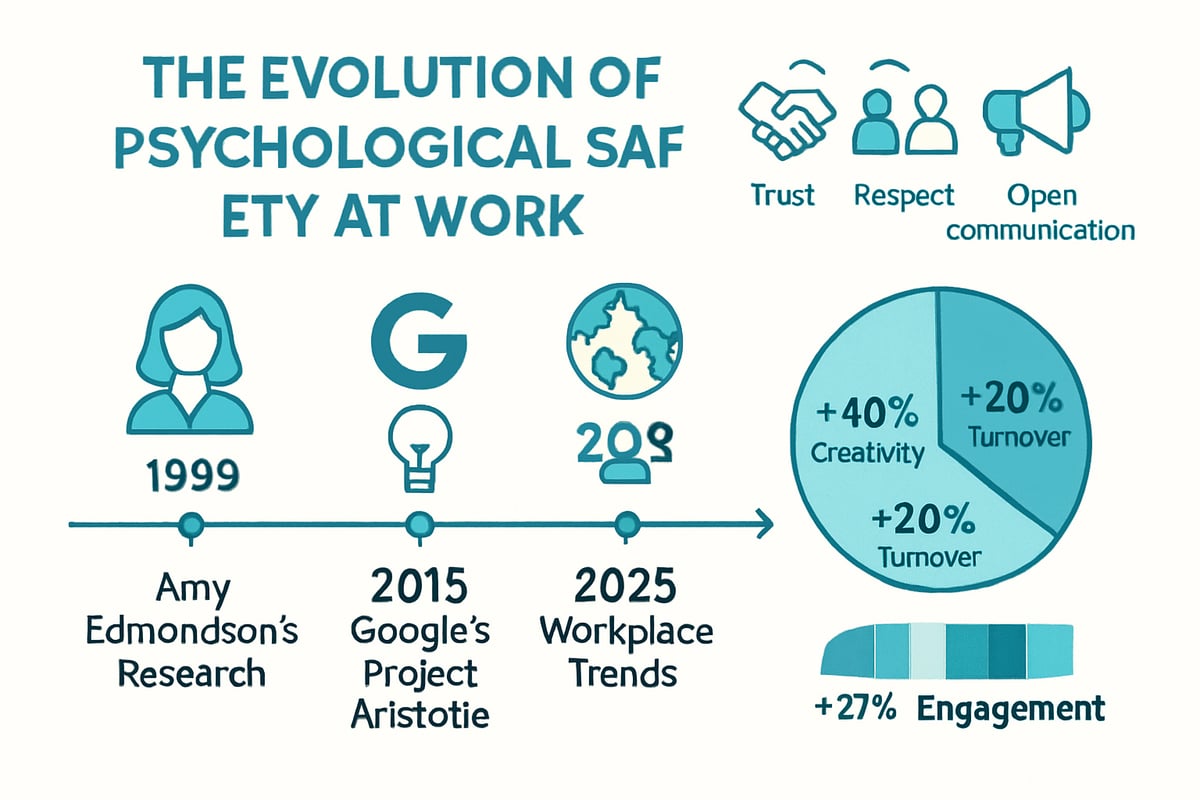
The Impact of Psychological Safety on Organizational Success
Psychological safety is no longer a buzzword. In 2025, it is a foundational pillar for organizations aiming to thrive in a rapidly changing landscape. When teams feel secure to express ideas, concerns, or challenges, the entire enterprise reaps measurable benefits.
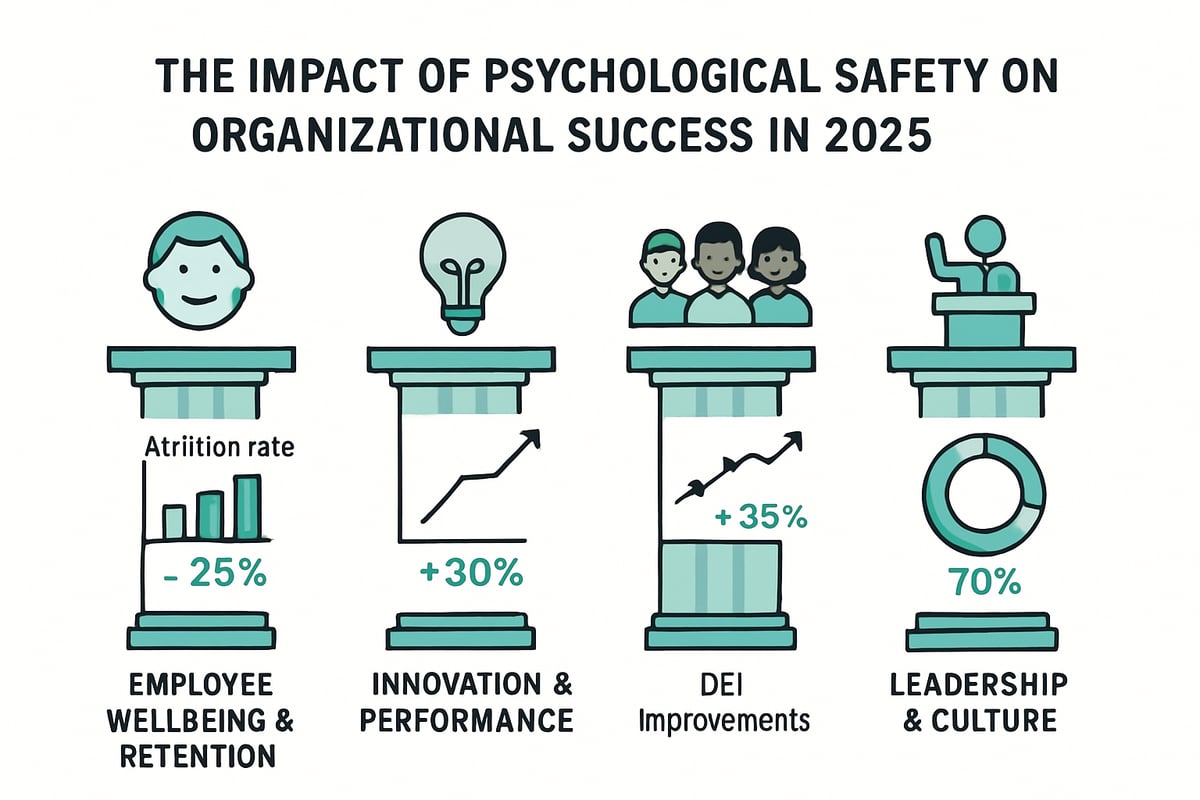
Employee Wellbeing and Retention
Organizations that prioritize psychological safety see dramatic reductions in burnout and improved mental health. According to recent research, companies with high psychological safety report lower turnover rates and higher employee satisfaction. For instance, leaders who foster these environments can reduce attrition risk to less than 3% of workers, as highlighted in Leaders Who Prioritize Psychological Safety Can Reduce Attrition Risk to Less than 3% of Workers. When employees see real-world examples of psychological safety at work, such as open conversations about stress or flexible support systems, they are more likely to stay, perform, and engage fully.
Innovation and Performance
The link between psychological safety and innovation is undeniable. Teams that feel safe are more willing to share unconventional ideas, take calculated risks, and learn from failures. Numerous studies show that when organizations implement strong examples of psychological safety at work, idea sharing and creative problem-solving soar. Breakthrough products often emerge from teams where members can question assumptions and experiment without fear of blame. These environments drive higher performance, faster learning, and more resilient strategies.
Diversity, Equity, and Inclusion (DEI)
Psychological safety is the backbone of effective DEI initiatives. Without it, diverse voices may remain unheard or undervalued. When organizations showcase robust examples of psychological safety at work, they empower all employees to contribute authentically. Data from global studies indicate that diverse teams in psychologically safe settings outperform their peers in innovation and problem-solving. Case studies from leading companies reveal that inclusive dialogue, fair feedback, and equitable opportunities are only possible when psychological safety is deeply embedded.
Leadership and Organizational Culture
Leadership sets the tone for psychological safety. Leaders who model transparency, listen actively, and admit mistakes create a culture where trust flourishes. These behaviors encourage teams to follow suit, reinforcing positive cycles of accountability and growth. By implementing examples of psychological safety at work—such as regular check-ins, open-door policies, and clear communication—organizations experience cultural transformation.
7 Essential Examples of Psychological Safety at Work in 2025
Psychological safety has become the backbone of high-performing teams and thriving organizations in 2025. To help leaders and employees build cultures where everyone feels secure to speak up, innovate, and challenge the status quo, we’ve compiled seven essential examples of psychological safety at work. Each example is grounded in real-world practice, actionable insights, and the latest research, ensuring you can apply these lessons to your own workplace.
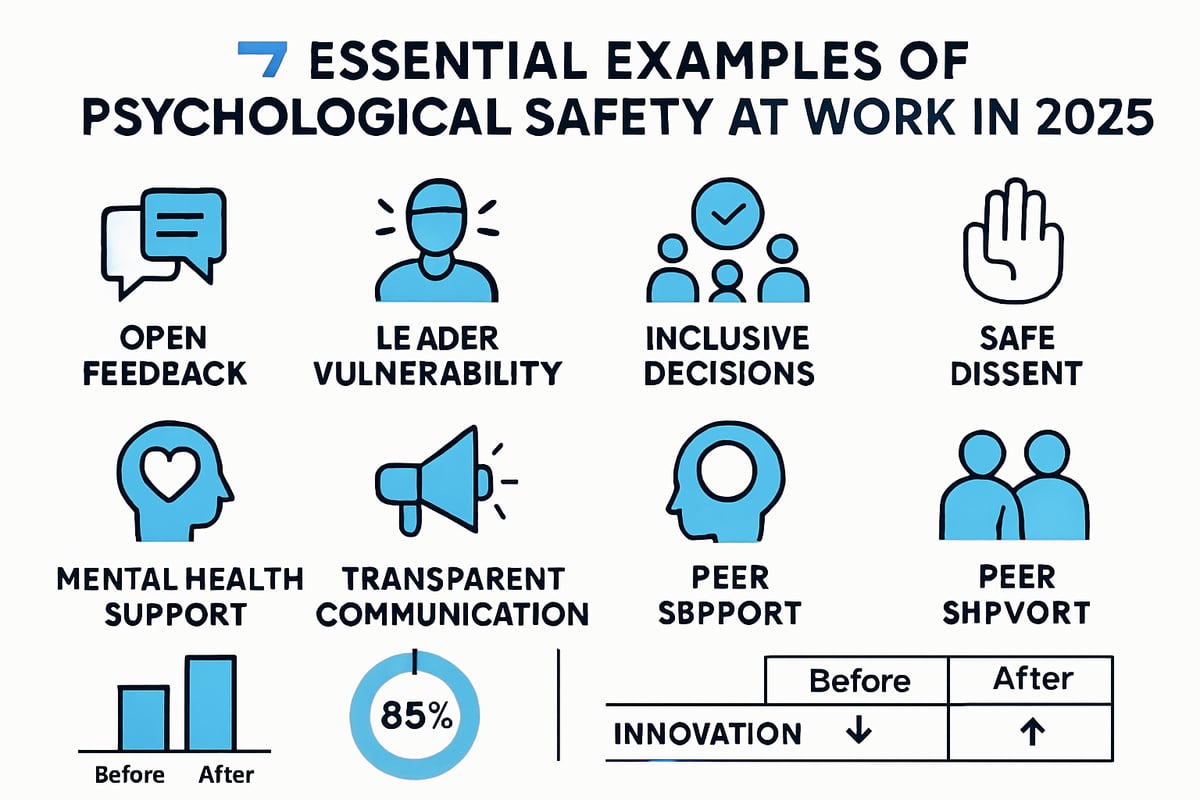
1. Open Feedback Loops and Constructive Dialogue
The first of our seven essential examples of psychological safety at work is the creation of open feedback loops. In 2025, organizations are moving beyond annual reviews and actively fostering environments where feedback is continuous, respectful, and actionable.
Teams now hold regular feedback sessions, both in-person and digitally, using tools like real-time feedback platforms and digital suggestion boxes. These approaches allow employees to share thoughts without fear of punishment. Many leading organizations use 360-degree feedback and anonymous channels, ensuring that everyone, regardless of role or level, can voice opinions safely.
Consider the following strategies:
- Schedule monthly feedback forums for open discussion.
- Implement digital suggestion boxes accessible to all.
- Train managers to facilitate feedback with empathy and objectivity.
According to real-world psychological safety examples, companies that prioritize open dialogue see measurable improvements in engagement scores, faster conflict resolution, and a notable drop in misunderstandings. Data from 2025 workplace surveys indicates that 82% of employees in psychologically safe environments report feeling comfortable voicing concerns, compared to just 46% in less supportive settings.
These examples of psychological safety at work demonstrate that feedback, when handled constructively, builds trust and accelerates team alignment. Open dialogue is not just a communication tool; it is the foundation for a resilient workplace culture.
2. Leaders Admitting Mistakes and Modeling Vulnerability
A culture of psychological safety thrives when leaders model vulnerability. One of the most impactful examples of psychological safety at work is when executives and managers openly admit mistakes, own their learning moments, and encourage their teams to do the same.
Leadership development programs in 2025 focus on authentic communication and the courage to be transparent. Leaders who share their failures, and what they learned from them, break down barriers. This honesty inspires teams to take calculated risks, knowing they will not be penalized for thoughtful experimentation.
Fortune 500 companies highlight stories where a leader’s public admission of a misstep led to increased trust and stronger team cohesion. For example, a technology executive who shared a failed product launch not only retained her team’s respect but also sparked a wave of creative problem-solving sessions. The outcome? Faster innovation cycles and more resilient teams.
Teams report that these examples of psychological safety at work lead to higher trust, better morale, and a willingness to innovate. Employees are more likely to share bold ideas, knowing their leaders value honesty over perfection.
3. Inclusive Decision-Making Processes
One of the most transformative examples of psychological safety at work is inclusive decision-making. In 2025, organizations are intentionally involving diverse perspectives at every stage, from brainstorming to final approval.
Best practices include:
- Round-robin input during meetings to ensure every voice is heard.
- Consensus-building frameworks that prioritize dialogue over hierarchy.
- Digital polling and anonymous idea submissions to capture a wide range of viewpoints.
Organizations that democratize decisions see higher employee buy-in and satisfaction. Research shows that inclusive processes lead to 30% better project outcomes and 45% higher engagement scores. Employees feel empowered when their input is genuinely considered, which fosters ownership and commitment.
A global consulting firm, for example, implemented inclusive decision-making for cross-border projects. The result was not just better solutions but also a deeper sense of belonging among team members. These examples of psychological safety at work prove that when everyone has a seat at the table, organizations unlock their full potential.
4. Safe Spaces for Dissent and Challenging the Status Quo
Creating safe spaces for dissent is another cornerstone among the essential examples of psychological safety at work. Employees must have explicit permission to challenge ideas, question assumptions, and propose alternatives without fear of negative consequences.
Many organizations now establish dedicated forums for constructive debate, such as “devil’s advocate” sessions and blameless post-mortems. Psychological contracts are established, making it clear that disagreement is not just tolerated but encouraged.
Agile teams, for instance, regularly hold retrospectives where team members openly discuss what worked, what did not, and how to improve. Tech companies have seen a direct link between these practices and higher rates of innovation. Recent data shows that teams with formal dissent channels generate 25% more breakthrough ideas.
For more real-world psychological safety examples, look to organizations that have embedded these forums into their culture. These examples of psychological safety at work demonstrate that challenging the status quo is not a threat but a catalyst for progress.
5. Support for Mental Health and Wellbeing Initiatives
In 2025, support for mental health and wellbeing is integral to the most effective examples of psychological safety at work. Companies are moving beyond traditional Employee Assistance Programs and embracing holistic mental health strategies.
Key initiatives include:
- On-demand counseling and virtual therapy.
- Scheduled mental health days as part of PTO policies.
- Integration of wellness apps and daily check-ins into team routines.
Organizations that prioritize mental health see tangible benefits. Statistics reveal a 35% drop in absenteeism and a 29% increase in productivity after launching comprehensive mental health programs. By normalizing mental health conversations, companies destigmatize seeking help and foster a culture of empathy.
A global software firm, for example, now starts each Monday with a voluntary mental health check-in, resulting in higher employee engagement and lower turnover. These examples of psychological safety at work show that supporting wellbeing is not only the right thing to do but also drives business results.
6. Clear Expectations and Transparent Communication
Transparency is vital among the leading examples of psychological safety at work. When employees understand their roles, goals, and how decisions are made, anxiety decreases and alignment increases.
Modern organizations use digital dashboards, regular all-hands meetings, and transparent updates from leadership to keep everyone informed. Clear role definitions and open communication channels reduce confusion and foster accountability.
Remote-first and hybrid teams especially benefit from these practices. A multinational retailer saw a 40% improvement in project delivery times after adopting real-time dashboards and weekly updates. Employees reported feeling more secure, less stressed, and better equipped to meet expectations.
These examples of psychological safety at work demonstrate that clarity and transparency are not optional—they are essential for building trust and driving performance.
7. Peer Support Networks and Allyship Programs
The final of our seven essential examples of psychological safety at work is the establishment of peer support networks and allyship programs. In 2025, organizations are investing in structures that empower employees to help one another and champion inclusivity.
Effective practices include:
- Peer mentoring and buddy systems for new hires.
- Employee resource groups (ERGs) dedicated to shared identities or interests.
- Allyship training that equips employees to support marginalized colleagues.
Companies with robust peer support systems report 28% higher retention rates and significantly improved morale. Inclusion metrics rise as employees feel seen, supported, and valued.
These examples of psychological safety at work highlight the power of community. By building strong networks of support, organizations ensure that every employee has an advocate and a safe space to grow.
Measuring and Sustaining Psychological Safety in 2025
Measuring and sustaining psychological safety is essential for organizations determined to thrive in the modern workplace. As leaders seek actionable examples of psychological safety at work, they must prioritize robust measurement and continuous improvement to ensure lasting impact.
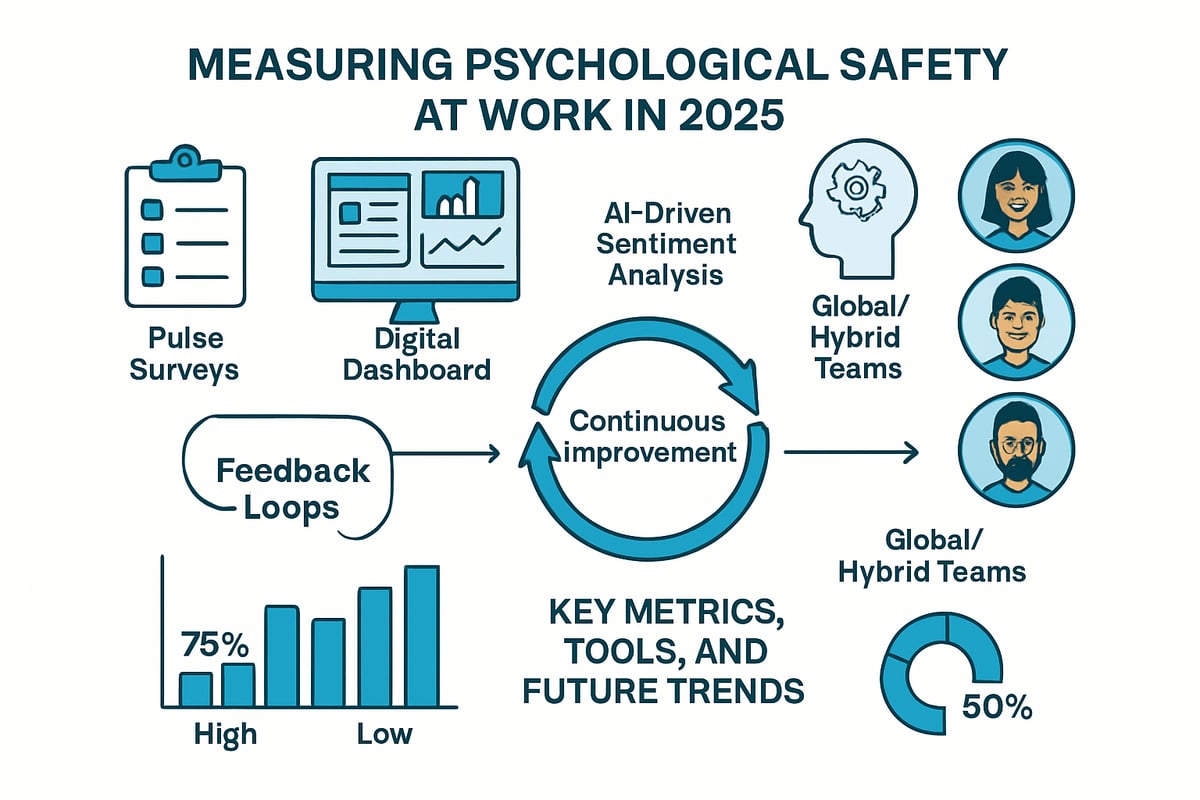
Key Metrics and Assessment Tools
Consistent measurement is foundational when embedding examples of psychological safety at work. Leading organizations rely on pulse surveys, psychological safety scales, and engagement scores to monitor team climates. These tools capture real-time feedback, track progress, and identify pain points. According to 30+ Psychological Safety at Work Stats [2025], over 70% of high-performing teams use digital dashboards and anonymous surveys to assess safety levels. The data empowers leaders to spot trends, address concerns, and benchmark against industry standards.
Best Practices for Ongoing Measurement and Feedback
Sustained psychological safety requires more than annual check-ins. High-trust organizations schedule regular feedback cycles, integrate psychological safety questions into engagement surveys, and leverage AI-driven tools for continuous sentiment analysis. Embedding these practices into daily workflows ensures leaders have up-to-date insights, enabling rapid response to emerging issues. For more on practical strategies, see building psychological safety strategies.
Strategies for Addressing Setbacks and Maintaining Momentum
No organization is immune to setbacks. When challenges arise, effective leaders respond with transparent communication and targeted interventions. They review feedback data, facilitate open forums, and provide additional support where needed. Sharing transparent progress reports and celebrating wins reinforces trust and keeps momentum strong. HR, managers, and employees all play active roles in driving continuous improvement, ensuring that examples of psychological safety at work remain visible and actionable.
Trends Shaping the Future: AI and Global Teams
The future of measuring psychological safety is data-driven and agile. AI-powered sentiment analysis and real-time culture dashboards offer deep insights into team dynamics, even across global and hybrid teams. These technologies help organizations quickly identify shifts in climate and adapt accordingly. Overcoming challenges in remote or multicultural settings requires tailored approaches, but the core principles of trust, respect, and open dialogue remain constant.
Conclusion: Sustaining a Culture of Psychological Safety
To achieve lasting change, organizations must treat measurement as an ongoing journey, not a one-time event. By prioritizing transparent metrics, embracing continuous feedback, and leveraging modern tools, leaders can embed the most effective examples of psychological safety at work. For deeper insights on accountability and leadership, explore Accountability Now and commit to building a thriving, resilient workplace culture.
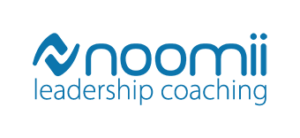
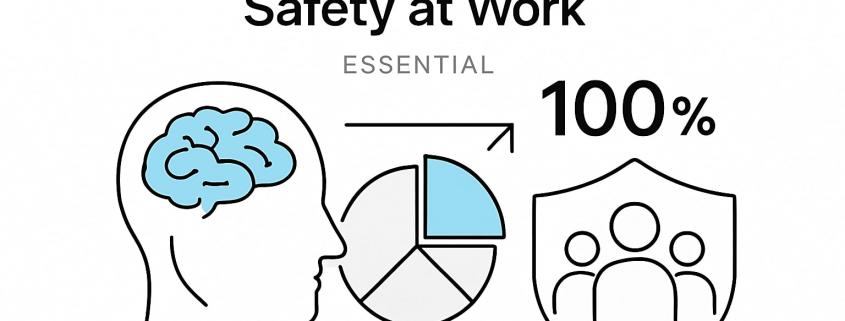


Leave a Reply
Want to join the discussion?Feel free to contribute!